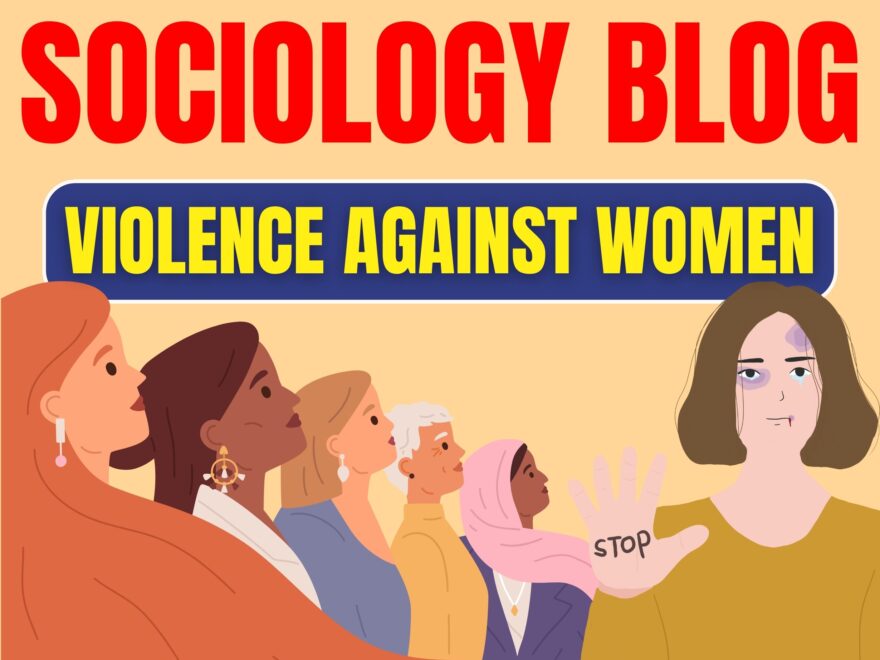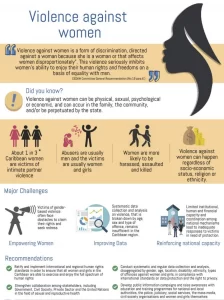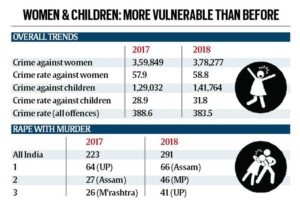Violence Against Women in India
(Relevant for Sociology Optional for Civil Services Examination)
Paper 2: Unit-13: Soical Changes in India; Challenges of Soical Transformation
Violence Against Women in India
|
“Male Violence Against Women in India is sufficiently common and repetitive to constitute a social structure” – SYLVIA WALBY |
- Violence Against Women in India is a form of gender-based violence that inflicts physical, sexual, psychological, social, cultural, and economic harm on women within society. This includes acts of violence, threats of such acts, as well as coercive or arbitrary denial of women’s freedom and liberty. Such violence occurs in both the public sphere and the private sphere of the family, and it is a deeply entrenched concept encompassing a wide range of abuses.
- It is associated with ‘force’ whether overt or covert used to wrest from a woman something that she does not want to give of her own free will, which causes her either physical injury or emotional trauma or both.
- According to Schuler, gender violence is defined as “any act involving use of force or coercion with intent of perpetuating and promoting hierarchical gender relations.”
- Liz Kelly has defined Violence Against Women in India as “any physical, visual, verbal or sexual act that is experienced by the woman or girl at the time or later as a threat, invasion or assault, that has the effect of hurting or disregarding or removing the ability to control one’s own behaviour or an interaction, whether this be within the workplace, the home, on the streets or in any other area of the community”.
- Violence affects the lives of millions of women worldwide, in all socio-economic and educational classes. It cuts across cultural and religious barriers, impeding the right of women to participate fully in society. Violence Against Women in India varies from domestic abuse, female feticide, dowry death and rape to child marriages and female circumcision. All are violations of the most fundamental human rights.
Various Forms of Violence Against Women in India
Violence Against Women in India is multifaceted, encompassing various levels of harm, including:
- Psychological Violence: This form of violence targets a woman’s mental and emotional well-being. It involves tactics such as yelling, insults, mockery, threats, abusive language, humiliation, harassment, contempt, and deliberate emotional neglect or isolation.
- Physical Violence: The most visible and direct form of violence ranges from physical acts like pushing, shoving, hitting, beating, using weapons, torture, mutilation, and even murder.
- Sexual Violence: Sexual violence includes any non-consensual sexual activity forced upon a person. It covers a spectrum from harassment and unwanted sexual touching to rape, and may also encompass incest.
- Financial Violence: This form of violence involves various tactics aimed at gaining control over a woman’s finances, inheritance, or employment income. It can include preventing a partner from working outside the home or engaging in activities that promote financial independence.
- Spiritual Abuse: Spiritual abuse seeks to destroy an individual’s cultural or religious beliefs through ridicule or punishment. It can involve forbidding the practice of one’s personal religion or forcing women and children to adhere to religious practices that are not their own.
- Intimidation: Intimidation as a form of violence includes making women fearful through looks, actions, gestures, property destruction, or displaying weapons.
- Isolation: Isolation is used as a means of control, limiting a woman’s social interactions, restricting where she goes, and whom she sees.
- Using Privilege: This form of violence involves using one’s privilege to exert control. Abusers may treat women or children as servants and insist on having the final say in all matters, rigidly adhering to traditional gender roles.
It’s important to note that Violence Against Women in India can manifest in subtle ways, not just through overt acts of physical harm. Contemptuous gestures, lewd remarks, obscene gestures, whistling, or leering can also leave lasting emotional scars. These forms of violence often overlap and are not mutually exclusive. Furthermore, Violence Against Women in India can take the form of deprivation, neglect, or discrimination, not solely relying on physical aggression. For example, intimate partner violence may involve sexual abuse, isolation, neglect, and psychological manipulation in addition to physical harm.
Life cycle of women and associated violence:
|
“Anxiety is other name of women in Indian context. She is surrounded by anxieties from puberty till death. She undergoes from one form of anxiety to another, anxiety to protect her body, pregnancy related anxiety, post-delivery anxiety and anxiety associated with her family”. – Lotika Sarkar |
| Phase of life | Violence associated |
| Pre natal | Female foeticide, Amartaya Sen highlights issue of missing women in India. |
| Infancy | natal inequality in form of neglect in terms of care and nutrition, |
| Childhood | child marriage, child sexual abuse , forced drop out from educational institutions, child pornography , incest violence |
| Adulthood | patriarchal s=discrimination and associated psychological violence , sexual harassment at work place , marital rape, forced pregnancies and abortions, rape , dowry related violence , courtship violence , trafficking and prostitution |
| Old age | physical violence and feminisation of elderly population and widowhood related inequality,lack of entitlement of property they are in state of poverty and distress |
Factors associated with Violence Against Women in India
- Patriarchal structures: The Violence Against Women in India is usually a manifestation of unequal power relations between men and women due to patriarchal structures present in society.
- Socialization: the socialization of male and female kids based on norms conforming to patriarchy. Patriarchal norms perpetuate an environment where Violence Against Women in India is tolerated and normalized. Societal expectations of women’s submissiveness contribute to their vulnerability. Nishi Mitra has studied domestic violence in India. She has found that socialization that leads to the powerlessness of women can ultimately result in violence against them.
- Cultural Beliefs and Practices: VEENA DAS says that the cultural enslavement of women is responsible for Violence Against Women in India. Deep-rooted cultural beliefs that reinforce women’s inferiority contribute to violence. Practices such as child marriage, dowry, and honour killings uphold oppressive gender roles.
- Caste and gender intersectionality :
-
- Kalpana Kannaviran believes that the single most important arena for the gendering of caste occurs in the arena of sexuality. The desire to regulate female sexuality has led to a considerable ritual preoccupation with female purity in the caste societies of Sri Lanka and India. Predictably, male sexuality is not ritualised in the same way.
- The commodification of women in the marriage market in patriarchal, patrilined caste society goes hand in hand with prescriptions for women’s behaviour and restrictions on their mobility, the dispossession of women in property and inheritance matters, and their absence in local level political and decision making bodies. The entire complex constituting the construction of gender in caste society is a construction that radically devalues the status of women in these societies.
- Economic Inequality: Socioeconomic disparities limit women’s access to resources and opportunities, making them more susceptible to various forms of violence, including economic exploitation and domestic abuse. Lack of excess to entitlements make women underclass and marginalised devoid of social, economic, cultural capital.
- Socio Political Factors: women have very low representation in different spheres of politics. Even if they are represented in local self-government, women are not effective decision makers. Structures like Panch Pati arise to reinforce patriarchy. Similarly discriminatory orientation at the level of political parties is also clearly visible.
- Weak Legal and Judicial Mechanisms: Inadequate enforcement of laws and limited access to justice fail to provide adequate protection and redress for victims of violence, emboldening perpetrators. Uma Chakarvoty says despite liberal legislations conditions of women remains unimproved because culture and patriarchal norms dominates statutory norms in day to day life. Madhu Kishwar and Ruth Vanita pose the women’s question by highlighting the incompatibility of Indian constitution law, violence, aggression and crimes against women.
- Lack of Awareness and Education: Insufficient education and information hinder women’s ability to challenge oppressive norms. Women mostly end up in informal sector for employment, making them vulnerable to violence.
- Absence of social justice: Ambedkar says absence of social justice highlights how caste-based discrimination and unequal power structures intersect with gender-based violence, exacerbating the vulnerability of Dalit women.
- Environmental degradation: Vandana Shiva connects Violence Against Women in India to environmental degradation, emphasizing the link between patriarchy, resource exploitation, and gender-based violence.
- Development induced displacement: Utsa Patnaik highlights how development induced displacement and rehabilitation plans have put tribal women in condition of sexual violence by contractors, hampering their cultural socialization.
- Media and Popular Culture: Media often perpetuates harmful stereotypes and objectification of women, normalizing violence and contributing to a culture of victim-blaming. Kilbourne says media presents mannequin image of women. Therefore media creates anxiety among women about their bodies. It causes emotional abuse of women.
CONSEQUENCES OF VIOELNCE AGAINST WOMEN
- Public Health Impact: Violence Against Women in India takes a toll on both physical and mental health, affecting their overall well-being. This includes a range of health issues, from physical injuries to mental health conditions like depression, suicidal ideation, and post-traumatic stress disorder. Additionally, it can lead to sexual dysfunctions. Access to healthcare and reproductive services may also become challenging for survivors.
- Economic Ramifications: The economic consequences of Violence Against Women in India are significant. It leads to decreased productivity and efficiency as women may be unable to work due to physical injuries or emotional distress. Consequently, this hampers their participation in the workforce and financial independence.
- Development Hindrance: Violence Against Women in India acts as a barrier to development and poverty alleviation. It impedes the equitable distribution of resources and opportunities, hindering women’s full participation in education and employment. Furthermore, it places a strain on law enforcement and judicial systems, resulting in substantial direct costs.
- Social Implications: Violence Against Women in India restricts women’s involvement in the public sphere, which is crucial for personal and societal growth. It curtails their ability to make decisions related to family planning and childbearing. Discrimination and violence against marginalized groups, such as Dalit women, compound existing social inequalities.
Brahmanical PatriarchyAccording to Uma Chakravarti, Brahmanical patriarchy is a social structure that was built in ancient India through the intersection of caste hierarchy and gender hierarchy It is a system of oppression that is deeply rooted in Indian society and is characterized by the collective subordination of women and lower-caste people Here are some of the key elements of Brahmanical patriarchy, as described by Chakravarti:
|
Suggestions to control Violence Against Women in India
- Gender neutral socialization should be focus of society. Gender-neutral socialization is an approach that challenges traditional gender norms and roles and promotes gender equality. By avoiding gender stereotypes, creating a more inclusive society, challenging gender norms, and promoting gender equality, gender-neutral socialization can help prevent gender-based violence and discrimination.
- Judith Butler’s work on gender performativity underscores the socially constructed nature of gender. By challenging and deconstructing traditional gender roles, societies can work towards creating a more inclusive and equal environment, reducing violence rooted in gender norms.
- Equal entitlement to men and women in family and society. Patriarchal entitlement creates discriminatory structures which not only perpetuates the hegemonic masculinity and violence but also prevent consciousness in women against exploitation and it becomes acceptable too. Implement policies that ensure equal pay for equal work and support work-life balance.
- Capacity building of women and economic empowerment by creating equal opportunities for women.
- Ranjana Kumari emphasizes the need for legal and policy reforms to combat Violence Against Women in India. She advocates for stronger legislation, improved enforcement, and better access to justice for survivors of gender-based violence.
- Equal representation of women in various spheres of politics, effective participation in decision making process be that in bureaucracy, legislature or corporate.
- Proper rehabilitation of women has been victims of violence. Along with it sensitization of concerned authorities is needed.
- Establishment of cheaper and less formal courts–courts to handle only female cases. The scope of existing family courts should be enlarged to include all types of domestic and non-domestic problems of women. Judges, magistrates and lawyers with knowledge and interests in female matters should be appointed.
- Strengthening and increasing voluntary organisation which could take up individual women’s problems with their in-laws, police, or the courts or the concerned individuals. Voice of an individual woman has less effect. Voices of women organised for a cause are more effective.
- Collect data on the prevalence of gender-based violence and its intersections with other forms of discrimination. Use research findings to inform policy and program development’
- Bell Hooks stresses the importance of challenging traditional notions of masculinity and femininity through education and media. She advocates for critical engagement with media representations to counter harmful stereotypes and promote healthy relationship.
- Recognize and address the unique challenges faced by marginalized groups, such as Dalit women, in the context of gender-based violence. Ensure their representation in decision-making processes.
From challenging patriarchal structures to promoting gender-neutral socialization, enforcing laws, and ensuring equal representation, the path forward is illuminated. By embracing these insights and working collectively, we can create a society where women are empowered, protected, and free from violence. It’s a journey toward a more equitable and just world that demands our unwavering commitment and action.
Frequently Asked Questions:
- Question: Define Violence Against Women in India and explain how it manifests in different forms.
Answer: Violence Against Women in India encompasses physical, psychological, and economic harm inflicted on women, including acts of force, coercion, and threats.
2. Question: Discuss the concept of Brahmanical patriarchy and its role in perpetuating gender-based violence in Indian society.
Answer: Brahmanical patriarchy is a social structure rooted in caste and gender hierarchies, idealizing female purity and enforcing economic dependence.
3. Question: What are the consequences of Violence Against Women in India on public health and economic development?
Answer: Violence Against Women in India leads to physical and mental health issues, decreased economic productivity, and hinders overall development.
4. Question: How can gender-neutral socialization contribute to preventing gender-based violence?
Answer: Gender-neutral socialization challenges traditional gender norms, promoting equality and reducing violence rooted in gender norms.
5. Question: Discuss the importance of equal representation of women in politics and decision-making processes in addressing gender-based violence.
Answer: Equal representation ensures women’s voices are heard and policies are enacted to combat violence.
6. Question: Explain the significance of collecting data on the prevalence of gender-based violence and its intersections with other forms of discrimination.
Answer: Data informs policy development and program implementation to address gender-based violence effectively.
7. Question: How can media and education play a role in challenging harmful gender stereotypes and promoting healthy relationships?
Answer: Media and education can counter stereotypes and encourage critical engagement with representations.
8. Question: Describe the role of voluntary organizations in addressing Violence Against Women in India and advocating for individual women’s rights.
Answer: Voluntary organizations provide support and amplify women’s voices for a collective impact.
9. Question: What steps can be taken to ensure proper rehabilitation and sensitization of authorities for victims of gender-based violence?
Answer: Rehabilitation programs and training for authorities are essential for effective support.
10. Question: How does Violence Against Women in India intersect with caste-based discrimination, and what measures can address this issue?
Answer: Caste-based discrimination exacerbates the vulnerability of Dalit women, requiring targeted interventions and representation.
Reference: Static Part
Related Blogs …
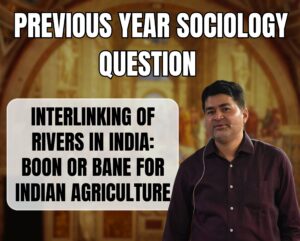 |
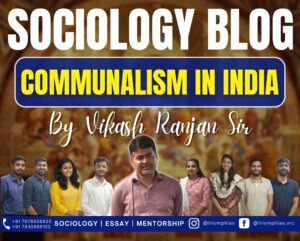 |

To master these intricacies and fare well in the Sociology Optional Syllabus, aspiring sociologists might benefit from guidance by the Best Sociology Optional Teacher and participation in the Best Sociology Optional Coaching. These avenues provide comprehensive assistance, ensuring a solid understanding of sociology’s diverse methodologies and techniques.
META TAGS:
Violence Against Women in India, Violence Against Women UPSC, Violence Against Women in society, Violence Against Women, gender-based violence, Brahmanical patriarchy, psychological violence, physical violence, economic violence, cultural beliefs, socialization, societal impact, solutions, gender equality, empowerment, Violence Against Women in Indian society, Violence Against Women
Why Vikash Ranjan’s Classes for Sociology?
Proper guidance and assistance are required to learn the skill of interlinking current happenings with the conventional topics. VIKASH RANJAN SIR at TRIUMPH IAS guides students according to the Recent Trends of UPSC, making him the Best Sociology Teacher for Sociology Optional UPSC.
At Triumph IAS, the Best Sociology Optional Coaching platform, we not only provide the best study material and applied classes for Sociology for IAS but also conduct regular assignments and class tests to assess candidates’ writing skills and understanding of the subject.
Choose The Best Sociology Optional Teacher for IAS Preparation?
At the beginning of the journey for Civil Services Examination preparation, many students face a pivotal decision – selecting their optional subject. Questions such as “which optional subject is the best?” and “which optional subject is the most scoring?” frequently come to mind. Choosing the right optional subject, like choosing the best sociology optional teacher, is a subjective yet vital step that requires a thoughtful decision based on facts. A misstep in this crucial decision can indeed prove disastrous.
Ever since the exam pattern was revamped in 2013, the UPSC has eliminated the need for a second optional subject. Now, candidates have to choose only one optional subject for the UPSC Mains, which has two papers of 250 marks each. One of the compelling choices for many has been the sociology optional. However, it’s strongly advised to decide on your optional subject for mains well ahead of time to get sufficient time to complete the syllabus. After all, most students score similarly in General Studies Papers; it’s the score in the optional subject & essay that contributes significantly to the final selection.
“A sound strategy does not rely solely on the popular
Opinion of toppers or famous YouTubers cum teachers.”
It requires understanding one’s ability, interest, and the relevance of the subject, not just for the exam but also for life in general. Hence, when selecting the best sociology teacher, one must consider the usefulness of sociology optional coaching in General Studies, Essay, and Personality Test.
The choice of the optional subject should be based on objective criteria, such as the nature, scope, and size of the syllabus, uniformity and stability in the question pattern, relevance of the syllabic content in daily life in society, and the availability of study material and guidance. For example, choosing the best sociology optional coaching can ensure access to top-quality study materials and experienced teachers. Always remember, the approach of the UPSC optional subject differs from your academic studies of subjects. Therefore, before settling for sociology optional, you need to analyze the syllabus, previous years’ pattern, subject requirements (be it ideal, visionary, numerical, conceptual theoretical), and your comfort level with the subject.
This decision marks a critical point in your UPSC – CSE journey, potentially determining your success in a career in IAS/Civil Services. Therefore, it’s crucial to choose wisely, whether it’s the optional subject or the best sociology optional teacher. Always base your decision on accurate facts, and never let your emotional biases guide your choices. After all, the search for the best sociology optional coaching is about finding the perfect fit for your unique academic needs and aspirations.
Follow us :
🔎 https://www.instagram.com/triumphias
🔎https://www.youtube.com/c/TriumphIAS
https://t.me/VikashRanjanSociology
Find More Blogs…
| Compare and contrast Karl Marx’s and Max weber’s | Karl Marx- Historical Materialism |
| Position of Women In the Modern Indian Society | Sociology: Social system and pattern variables |

